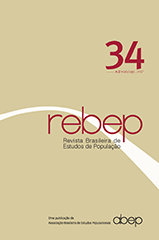Venezuela's melting pot: 1500-1800
DOI:
https://doi.org/10.20947/S0102-3098a0023Keywords:
Venezuela, Population, Mission, MestizajeAbstract
Not much is known about the demography of the native population of Venezuela in Colonial times. Until mid-17th century, some factual information may be gained from the narratives of the first conquistadores, missionaries and colonists, as well as of authors writing in later times of the Colony, but with access to original sources. After mid-17th century, some quantitative information of demographic relevance was collected by the Jesuit, Capuchin and Franciscan missionaries and, in the last decades of the 18th century, by the colonial administration and the religious authorities. The native population declined, from between 200,000 and 500,000 inhabitants at contact (guesstimates of modern authors) to perhaps 120,000 in 1800, according to Humboldt’s estimate. It is possible that the initial decline became steeper after the first smallpox pandemic of the 1580s and continued, at a slower pace, until the Independence. As in other regions of South America, marriage was early and almost universal, and the high ratio of births to deaths seems to indicate a high potential for growth, interrupted by frequent mortality crisis.
A competing cause of the decline of the natives was the process of mestizaje that intensified with the increase of the population of European and African origin.
Downloads
References
AGUADO, F. P. de. Recopilación historial. Bogotá: Biblioteca de Historia Nacional, Imprenta Nacional, 1906.
ARCHILA, R. Historia de la Medicina en Venezuela. Epoca Colonial. Caracas: Vargas, 1961.
ARELLANO MORENO, A. Relaciones geograficas de Venezuela. Caracas: Biblioteca de la Academia Nacional de la Historia, 70, 1964.
ARSI. Archivum Romanum Societatis Jesu, Rome.
ASTRAIN, A. Historia de la Compañia de Jesús en la asistencia de España. Madrid: Razón y Fe, Tomo VII, 1925.
CAULIN, A. Historia coro-grafica, natural y evangelica de la Nueva Andalusia, provincia de Cumanà,Guayana y vertientes del Rio Orinoco. Madrid, 1779.
CHEN, C.; PICOUET, M. Dinámica de la población: caso de Venezuela. Caracas: UCAB-ORSTOM, 1979.
COALE, A. J.; DEMENY, P. Regional model life tables and stable populations. Princeton: Princeton University Press, 1966.
GILIJ, F. S. Saggio di storia americana, o sia, storia natura civile, e sacra, de’ regni, e dele provincie Spagnuole di Terra-ferma nell’America meridionale. Roma: Luigi Perego Salvioni, 1784.
GUERRA, F. Epidemiología Americana y Filipina 1492-1898. Madrid: Ministerio de Sanidad y Consumo, 1999.
GUMILLA, J. El Orinoco ilustrado. Historia natural, civil y geographica de este gran rio y de sus caudalosas vertientes. Madrid: Manuel Fernandez, 1741.
HUMBOLDT, A. von. Viaje a las regions equinocciales del nuevo Continente. Caracas: Monte Avila, Tomo V, 1991.
_________. Voyage aux régions écquinoxiales du nouveau continent fait n 1799, 1800, 1801, 1802, 1803 et 1804, fait par Al de Humboldt et A. Bonpland, rédigé par A. de Humboldt. Paris: Schoell, Tomo 1, 1814.
_________. Voyage aux régions écquinoxiales du nouveau continent fait n 1799, 1800, 1801, 1802, 1803 et 1804, fait par Al de Humboldt et A. Bonpland, rédigé par A. de Humboldt. Paris: Maze, Tomo 2, 1819.
_________. Voyage aux régions écquinoxiales du nouveau continent fait n 1799, 1800, 1801, 1802, 1803 et 1804, fait par Al de Humboldt et A. Bonpland, rédigé par A. de Humboldt. Paris: Smith, Tomo 3, 1825.
LIVI-BACCI, M. The depopulation of upper Amazonia in Colonial times. Revista de Indias, v. LXXVI, n. 267, p. 419-48, 2016.
_________. Conquest. The destruction of the American indios. Cambridge: Polity Press, 2008.
MARTÍ, M.; CANEDO, L. Documentos relativos a su visita pastoral de la Diocesis de Caracas. Fuentes para la historia colonial de Venezuela. Caracas: Academia Nacional de la Historia, 7 vols. 1989.
OVIEDO Y BAÑOS, J. de. Historia de la conquista y población de la Provincia de Venezuela ilustrada con notas y documentos por el capitan de navio Cesareo Fernandez Duro. Madrid: Luis Navarro, Editor, 1885 [1723].
OVIEDO, F. G. Historia general y natural de las Indias. Madrid: Biblioteca de Autores Españoles, 5 vol., 1992.
RIONEGRO, F. R. Misiones de los padres capuchinos. Pontevedra, 1930. RIVERO, J. Historia de las Misiones de los LLanos de Casanare y los Rios Orinoco y Meta. Bogotá, 1883.
ROSENBLAT, A. La población indigena y el mestizaje en America. La población indigena. Buenos Aires: Editorial Nova, v. I, 1954.
SIMON, P. Noticias historiales de las conquistas de Tierra Firme en las Indias Occidentales, 1882.
VAZQUEZ DE ESPINOSA, A. Compendio y descripción de las Indias Occidentales. Washington: Smithsonian, 1948.
VELASCO, J. L. de. Geografia y descripción universal de las Indias. Madrid: Fortanet, 1894.
VILA, P. Geografia de Venezuela: el territorio nacional y su ambiente fisico. Caracas: Ministerio de Educacion, v. 1, 1960.
_________. Geografia de Venezuela: el paisaje natural y el paisaje humanizado. Caracas: Ministerio de Educacion, 1965.
Downloads
Published
How to Cite
Issue
Section
License
Papers published in Rebep are original and protected under the Creative Commons attribution-type license (CC-BY). This license allows you to reuse publications in whole or in part for any purpose, free of charge, even for commercial purposes. Any person or institution can copy, distribute or reuse the content, as long as the author and the original source are properly mentioned.

